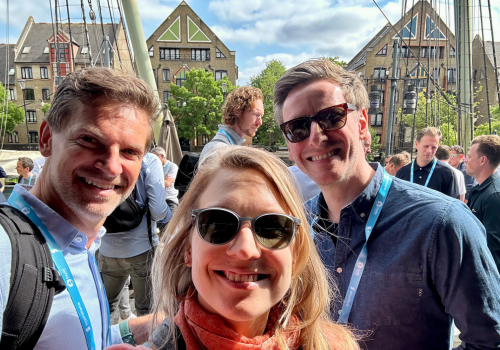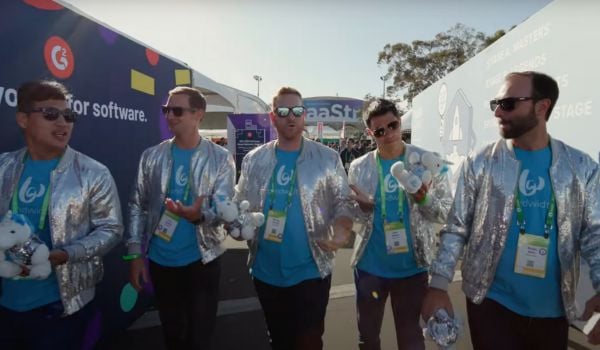Unlock Sales: The Small Business Guide to B2B Conferences
After personal network, B2B conferences are the most important sales channel for B2B companies. They're not just events; they're powerful platforms for businesses to connect, collaborate, and close deals.
Big companies have the money and name to get noticed at these events. But for small businesses with less resources, it's tough. In this article, we share strategies to make the most of upcoming conferences for your small business.
Listen to the podcast:
Benefits of B2B Conferences for Small Businesses
For small businesses trying to make their mark, B2B conferences can be a game-changer.
Direct Access to Audience
Attending these events provides direct access to your desired audience. Whether industry giants or fellow small business owners, various B2B companies of all sizes participate, offering an invaluable opportunity for smaller firms to connect with diverse professionals.
Networking Opportunities
These conferences go beyond talks and seminars. They’re full of professionals exploring new avenues. They provide the ideal setting for small businesses to initiate dialogues, establish connections, and discover potential clients or partners. Spontaneous interactions foster potential collaborations.
Personal Growth
Beyond business networking, these events hold an intangible charm. They bring together a unique blend of individuals driven by a thirst for learning, sharing, and inspiration. The conference ambiance resonates with forward-thinking energy, creating a refreshing experience. It's about more than deals – it's immersing oneself in novel experiences, forming genuine relationships, and reconnecting with partners beyond formal settings. The result? An atmosphere charged with positivity, innovation, and authentic human connection.

Challenges for Small Businesses during B2B Conferences
Participating in B2B conferences presents unique challenges for small businesses. Large corporations can splash out up to a million on eye-catching stands, engaging talks, sponsorships, and other grand gestures. As a small business with a budget that barely covers the entrance and travel costs, standing out at a conference can feel like a lost battle.
The financial strain combined with the time and energy devoted to B2B conferences can be taxing. It's normal for small businesses to question whether they're truly getting their money's worth from those events.
Once you finally got home and ready to catchup on sleep and daily business, you still face the daunting task of following up with everyone met to ensure no business opportunity slips away. Balancing this with prepping for future events and everyday business tasks can easily become overwhelming.
Yet, the key to extracting value from these events lies in preparation. A well-thought-out strategy and effort invested before the conference can greatly enhance the benefits and potential returns.
Strategies to Make the Most out of your Next B2B Conference
Small businesses, working with limited budgets, need to be more creative to leave an impression. To ensure you maximize your opportunities at the next conference, you should view it as a project: Build an action plan with 3 phases: pre-conference, during conference and post-conference.
Pre-Conference Action Plan for Small Businesses
Step 1 - Screen Attendees
Four weeks before the conference, go through the conference platform and create a list of potential leads from the conference attendees
Step 2 - Focus on Value
Three weeks before the conference, send each contact on your list a personalised message with a link to your best piece of content (podcast, webinar, blog article). Don't just guess. Check out Google Analytics and your podcast stats to see which content gets the most visitors in the last 30 to 90 days. With your first email, focus on providing value and make a great first impression. Don’t ask for anything. But make sure to mention in your introduction sentence that you will be attending the same conference and that’s where you found their contact.
Step 3 - Ask Questions
Two weeks prior to the conference, send them a follow-up with a link to your self-assessment, benchmark or online test to learn more about where they are in your customer journey. If you made a great impression with your first email (even if they didn’t reply), they’re more likely to answer your questions in the survey. Having a system to engage and ask questions to your potential new customers is key to be able to provide timely and valuable content later on.
Step 4 - Book 1:1 Meetings
One week before the event, make sure to book 1-on-1 or group meetings with the most engaged and promising contacts from your list. Also, rehearse your pitch as many times as needed so you can tell it in 3 different languages flawlessly (if you speak that many languages). Plus points if you can break down 3 insights from your own data (generated by your benchmark or online assessment) about the current state of your industry as talking points for spontaneous networking during the conference.
Collect your Own Data
By collecting your own data about the most relevant topics for your target audience, you position your company as a leading player in your field. You also gain valuable and unique market insights, on which you can build great content pieces to further highlight your expertise.
During Conference: Bring your A-Game
First, standing out and being memorable is about being authentic (not necessarily about dressing funny like the 5 men below). People go to conference to meet people, so the first step to standing out is to let people see the real you. Don’t try to fit the dress code, but rather wear what you feel most comfortable with.

Second, meet as many people as you can: check for last-minute 1:1 meetings or round table meetings, and go to networking lunches and aperos.
When you talk to people, mention the insights from your industry benchmark to position yourself as leading company with unique insights and proprietary data.
Engage your audience even more by asking them relevant questions from your benchmark or assessment.
If appropriate, add people right away on LinkedIn and take note about your encounter. Notes will be very useful to send personalised follow-ups after the conference is over. Especially when you talk to 10-30 people a day.
List Everyone you Meet
If you can’t take note, find a way to create a list of all the people you meet. For example, take a picture of the badge of all people you talk to. Even and especially if you add them right away on LinkedIn. LinkedIn is a great networking tool, but it’s not so good as helping you keep track of new connections.
Post-Conference Action Plan
Categorise Everyone you Met at the Conference
Once you left the conference, use the time in the plane or train to categorise everyone you met in 3 categories. A-contacts = want an offer and are ready to buy now. B-contacts might want to buy in the near future, but they are still exploring multiple options. C-contacts are not buying, either because they have no budget or because your offer doesn’t relate to their current focus.
How to Differentiate Between B- and C-Leads
Often it can be hard to differentiate between B and C leads. B leads do not qualify themselves easily in a first interaction. You need to follow up nicely, you need to make your case, and then they might buy from you. Very often, sales people only differentiate between good leads = want to buy now (A) and all the others. As a result, they miss out on opportunities with B-leads.
Follow-Up Strategies Post-Conference
Contacts who want to buy (A)
You want to follow up with A-contacts within 1-2 days with personalised offers.
Contacts who may want to buy in the future (B)
For B-contacts, you can invite them to your next online event. If you don’t have one lined up, plan one. Hosting online events is a good opportunity for your contacts to learn more about you and figure out if you are the right partner for them. It can be a value-packed webinar, a panel discussion, a Q&A session with experts, or a fireside chat with someone in your team, a client or a business partner.
If there are B-contacts in your list that haven’t received your emails pre-conference, create an email sequence where you first invite them to your upcoming event. Two weeks later, send them your best piece of content. And finally, two weeks after that, send them your industry benchmark to learn more about their challenges.
Contacts who don't want to buy (C)
When it comes to C-contacts, if you follow up too early too much, they might mark you as spam and unsubscribe from your emails. We don’t want that. I won’t tell you to follow up 12 months from now because you and I know it will never happen. So do this instead: once you have followed up with all your A- and B-leads, schedule an email campaign going out to all your C-leads 10 months from now.
The email could start like this: Hey, we met last year at the XYZ conference. Here’s what we’ve been up to.
You can share links to your social media, blog or podcast. Choose links you know will still be valid in 10 months.
Then, next year, if you go again to the conference you can go again through the same pre-conference action plan and send them links to your industry benchmark and best content and so on.
Examples
Richmond Events
A few years ago, Marc attended one of Richmond conferences.
Richemond Conference are upscale B2B gatherings where Industry-leading decision makers participate to high-priced and high-paced speed meeting sessions, within the stunning backdrop of luxurious five-star venues like the Bürgenstock or Bad Ragaz.
Prior to the event, participants prepare online, sharing their current challenges—a practice that occasionally uncovers hidden gems during the subsequent insightful conversations. In the evenings, people convene at the bar. Making a lasting impression in this context is an art.
In Marc’s experience, the best way to get people interested is to genuinely connect through quality conversations and extend invitations for future interactions.
SaaStr Europa
SaaStr Europa stands as a remarkable conference to attend for companies in the SaaS space, seamlessly blending its American essence with the vibrant European tech landscape. Hosted in dynamic cities like London, Paris or Barcelona, the event's charm is amplified by its pre-event match-making mechanisms, fostering valuable exchanges and connections during the conference.
For example, this year in London, I hold a so-called “braindate”. I posted a topic and time and 6 people signed up to my session. I presented the work we do at Cotide and answered questions about our solution.
At the conference, attendees engage in meaningful conversations, exchanging insights, gauging compatibility, and discerning the presence of buying intent—often a challenging combination to find.
Hubspot Inbound Conference in Boston
The Inbound Conference stands out from the crowd as a unique and transformative event. Unlike traditional gatherings, Inbound doesn't just offer a platform for networking and showcasing products; it's a hub of inspiration, education, and innovation.
Designed for those seeking to revolutionize their approach to sales and marketing, Inbound provides a holistic experience that transcends the boundaries of industries and roles. Its focus on inbound methodologies, customer-centric strategies, and data-driven insights aligns perfectly with the modern sales approach.
By understanding customers deeply, tailoring interactions to their needs, and leveraging data to drive decisions, sales professionals can find immense value in the actionable insights gained at Inbound.
Trekksoft's Success in Getting Clients with B2B Conferences
15 years ago, Valentin co-founded Trekksoft, a tour operator booking software. For years, Trekksoft has relied on events and conferences as a central sales tool.
Organising your Own Events
Beyond having a stand at key conferences with 1 to 3 sales representatives, Trekksoft has orchestrated its own events, conferences, info sessions and breakfast gatherings in collaboration with local partners like tourism boards. Valentin went on tour in Italy, Norway or Spain to speak in front of the target audience.
Boosting Customer Relations
Trekksoft didn’t only use conferences to find new clients, but also to strengthen relationships with existing ones. The company invited their best clients to dinners and exclusive events, fostering a sense of exclusivity.
Sponsoring & Speaking
Further, they've immersed themselves as sponsors in industry reports and taken the stage as subject-matter experts. They were invited to roundtable discussions and delivered presentations that piqued interest and captivated attention.
Make it Personal
The secret to their success lies in the pursuit of personalized connections. Remarkably, they've approached ROI with meticulousness, attempting to quantify the leads gained at initial contact during conferences and assessing their conversion to customers along with the subsequent ARR generated within six months. While challenging, this approach underscores their commitment to data-driven decision-making.
Persistence Pays Off
Trekksoft's journey is emblematic of the classic B2B narrative, evolving from being unknown to eventually being invited onstage as subject-matter expert. Their growth trajectory confirms the old adage that persistence pays off. As Valentin said: “You have to go 3 years in a row to the same conference to start seeing results. The first time, you get ignored because all sales people know each other and nobody wants to do business with the new kid on the block. The second year, people recognise you and the third year, people start to take you seriously.”
Trekksoft's story is a testimony to the power of conferences for small business to grow. Consistent engagement, strategic insights, and personalized interactions can propel a company to new heights.
Make It Efficient
Going to conferences to find new clients is a lot of work and energy. But, with the right tools and technology, you can make it an enjoyable sales process for you and your newfound contacts.
Leverage AI & Automation
Craft automated funnels that initiate outreach and systematically follow up with leads. Enhance your approach by launching an industry survey to collect insightful data. As you accumulate information, leverage AI to orchestrate follow-ups, delivering tailored emails and relevant content at a scale that was once unimaginable.
Combining cutting-edge technologies with your personal touch ensures that your post-conference interactions are not only efficient but also deeply meaningful, maximizing the potential for conversion and long-term relationship building.
Discover your Potential to Build an AI-Powered Lead Generation System
Make your life easier with AI and marketing automation by completing our 3-min assessment
Share this
You May Also Like
These Related Stories

What Are the Most Important Touchpoints of a Buyer Journey in B2B?

How to Make Sales and Marketing Alignment Work in B2B?
